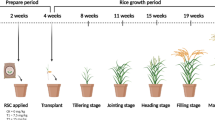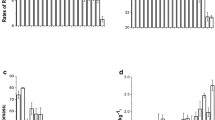Abstract
To attempt to understand certain mechanisms causing the variations between rice cultivars with regard to Cd uptake and accumulation, pot soil experiments were conducted with two rice cultivars at different levels of Cd, i.e., 0 (the control), 10, 50 mg Cd kg−1 soil. The two rice cultivars differ significantly with regard to Cd uptake and accumulation. Root secretions of low-molecular-weight organic acids (LMWOA) for each treatment were measured with ion chromatography. The results showed that LMWOA concentrations in the soil planted with Shan you 63 (a high soil Cd accumulator) were all higher than those in the soil planted with Wu yun jing 7 (low soil Cd accumulator) at different soil Cd levels, although the magnitudes of the differences varied for individual LMWOA and depend on soil Cd concentrations. For all six LMWOA, there were significant differences at P < 0.05 or < 0.01 levels for soils treated with 10 and 50 mg kg−1 Cd. The magnitude of the differences was greater under soil Cd treatments, especially at relatively low levels (for example, 10 mg Cd kg−1 soil), than in the control. Acetic acid and formic acid constituted more than 96% of the total concentration of the six LMWOA, while citric acid constituted only about 0.1%. The rice cultivar with higher concentrations of LMWOA in soil accumulated more Cd in the plants. The results indicate that LMWOA secretion by rice root, especially in Cd-contaminated soils, is likely to be one of the mechanisms determining the plant Cd uptake properties of rice cultivars.


Similar content being viewed by others
References
Allen, S. E. (1989). Analysis of vegetation and other organic materials. In S. E. Allen (Eds.), Chemical analysis of ecological materials (pp. 46–61). Oxford: Blackwell.
Baziramakenga, R., Simard, R. R., & Leroux, G. D. (1995). Determination of organic acids in soil extracts by ion chromatography. Soil Biology and Biochemistry, 27, 349–356.
Bremner, J. M. (1996). Nitrogen—total. In D. L. Sparks (Ed.) Methods of soil analysis, part 3. SSSA Book Series no 5. Madison, WI: SSSA and ASA
Cataldo, D. A., McFadden, K. M., Garland, T. R., & Wildung, R. E. (1988). Organic constituents and complexation of nickel (II), iron (III), cadmium (II) and plutonium (IV) in soybean xylem exudates. Plant Physiology, 86, 734–739.
Cieslinski, G., Van Rees, K. C. J., Szmigielska, A. M., Krishnamurti, G. S. R., & Huang, P. M. (1998). Low-molecular-weight organic acids in rhizosphere soils of durum wheat and their effect on cadmium bioaccumulation. Plant and Soil, 203, 109–117.
Jones, D. L., & Darrah, P. R. (1994). Role of root derived organic acids in the mobilization of nutrients from the rhizosphere. Plant and Soil, 166, 247–257.
Jones, D. L., Darrah, P. R., & Kochian, V. L. (1996). Critical evaluation of organic acid mediated iron dissolution in the rhizosphere and its potential role in root iron uptake. Plant and Soil, 180, 57–66.
Kabata-Pendias, A., & Pendias, H. (2001). Trace elements in soils and plants. Boca Raton: CRC Press.
Liu, J., Li, K., Xu, J., Liang, J., Lu, X., Yang, J., & Zhu, Q. (2003). Interaction of Cd and five mineral nutrients for uptake and accumulation in different rice cultivars and genotypes. Field Crops Research, 83, 271–281.
Liu, J., Zhu, Q., Zhang, Z., Xu, J., Yang, J., & Wong, M. H. (2005). Variations in cadmium accumulation among rice cultivars and types and the selection of cultivars for reducing cadmium in the diet. Journal of the Science of Food and Agriculture, 85, 147–153.
Lombi, E., Wenzel, W. W., Gobran, G. R., & Adriano, D. C. (2001). Dependency of phytoavailability of metals on indigenous and induced rhizosphere processes: a review. In G. R. Gobran, W. W. Wenzel, & E. Lombi (Eds.), Trace elements in the rhizosphere (pp. 4–23). Boca Raton: CRC Press.
Lundstrom, U. S. (1993). The role of organic acids in the soil solution chemistry of a podsolized soil. Soil Science, 44, 121–133.
Mench, M., & Martin, E. (1991). Mobilization of cadmium and other metals from two soils by root exudates of Zea mays L., Nicotiana tobacum L., and Nicotiana rustica L. Plant and Soil, 132, 187–196.
Morishita, T., Fumoto, N., Yoshizawa, T., & Kagawa, K. (1987). Varietal differences in cadmium levels of rice grains of Japonica, Indica, Javanica and hybrid varieties produced in the same plot of a field. Soil Science and Plant Nutrition, 33, 629–637.
Naidu, R., & Harter, R. D. (1998). Effect of different organic ligands on cadmium sorption and extractability from soils. Soil Science Society of America Journal, 62, 644–650.
Nakayama, E. (1981). Chemical speciation of chromium sea water: Effect of naturally occurring organic materials on the complex formation of chromium III. Analytica Chimica Acta, 130, 289–294.
Nigam, R., Srivastava, S., Prakash, S., & Srivastava, M. M. (2001). Cadmium mobilisation and plant availability—the impact of organic acids commonly exuded from roots. Plant and Soil, 230, 107–113.
Senden, M. H. M. N., & Wolterbeek, H. T. (1990). Effect of citric acid on the transport of cadmium through xylem vessels of excised tomato stem-leaf systems. Acta Botanica Neelrlandica, 39, 297–303.
Srivastava, S., Prakash, S., & Srivastava, M. M. (1999). Chromium mobilization and plant availability—the impact of organic complexing ligands. Plant and Soil, 212, 203–208.
Takijima, Y. (1964). Study on organic acids in paddy field soils with reference to their effects on the growth of rice plant. Soil Science and Plant Nutrition, 10, 14–29.
Tiffin, L. O. (1970). Translocation of iron citrate and phosphorus in xylem exudate of Soybean. Plant Physiology, 45, 280–283.
Tiffin, L. O. (1972). Translocation of micronutrients in plants. In J. J. Mortvedt (Ed.), Micronutrients in agriculture (pp. 199–229). Madison: Soil Science Society of America.
Wu, Q. T., Chen, L., & Wang, G. S. (1999). Differences on Cd uptake and accumulation among rice cultivars and its mechanism. Acta Ecologica Sinica, 19, 104–107 (in Chinese).
Yang, X. E., Baligar, V. C., Foster, J. C., & Martens, D. C. (1997). Accumulation and transport of nickel in relation to organic acids in ryegrass and maize grown with different nickel levels. Plant and Soil, 196, 271–276.
Acknowledgements
The authors would like to thank the Science and Technology Project of Changzhou (CS2005003) and the Research Grants Council (HKBU2181/03M) of Hong Kong for financial support.
Author information
Authors and Affiliations
Corresponding author
Rights and permissions
About this article
Cite this article
Liu, J., Qian, M., Cai, G. et al. Variations between rice cultivars in root secretion of organic acids and the relationship with plant cadmium uptake. Environ Geochem Health 29, 189–195 (2007). https://doi.org/10.1007/s10653-006-9063-z
Received:
Accepted:
Published:
Issue Date:
DOI: https://doi.org/10.1007/s10653-006-9063-z




